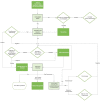Diagnostic and therapeutic considerations for obscure gastrointestinal bleeding in patients with chronic kidney disease
- PMID: 30837783
- PMCID: PMC6394262
- DOI: 10.20524/aog.2018.0341
Diagnostic and therapeutic considerations for obscure gastrointestinal bleeding in patients with chronic kidney disease
Abstract
Recurrent obscure gastrointestinal bleeding amongst patients with chronic kidney disease is a challenging problem gastroenterologists are facing and is associated with an extensive diagnostic workup, limited therapeutic options, and high healthcare costs. Small-bowel angiodysplasia is the most common etiology of obscure and recurrent gastrointestinal bleeding in the general population. Chronic kidney disease is associated with a higher risk of gastrointestinal bleeding and of developing angiodysplasia compared with the general population. As a result, recurrent bleeding in this subgroup of patients is more prevalent and is associated with an increased number of endoscopic and radiographic procedures with uncertain benefit. Alternative medical therapies can reduce re-bleeding; however, more studies are needed to confirm their efficacy in this subgroup of patients.
Keywords: Obscure gastrointestinal bleeding; angiodysplasia; arteriovenous malformations; chronic kidney disease; small-bowel bleeding.
Conflict of interest statement
Conflict of Interest: None
Figures

References
-
- Gerson LB. Causes of gastrointestinal hemorrhage in patients with chronic renal failure. Gastroenterology. 2013;145:895–897. discussion 897. - PubMed
-
- Zuckerman GR, Cornette GL, Clouse RE, Harter HR. Upper gastrointestinal bleeding in patients with chronic renal failure. Ann Intern Med. 1985;102:588–592. - PubMed
-
- Kalman RS, Pedrosa MC. Evidence-based review of gastrointestinal bleeding in the chronic kidney disease patient. Semin Dial. 2015;28:68–74. - PubMed
-
- Sakai E, Endo H, Taniguchi L, et al. Factors predicting the presence of small bowel lesions in patients with obscure gastrointestinal bleeding. Dig Endosc. 2013;25:412–420. - PubMed
Publication types
LinkOut - more resources
Full Text Sources
Research Materials
